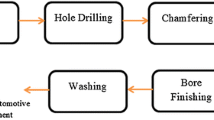Abstract
In recent times, the focus of sustainable development has been shifted toward the process domain to achieve greater environmental benefits. Improved sustainability in the process domain can be achieved by selecting sustainable process or through improvement studies. In this study, sustainability performance of injection molding (IM) and selective laser sintering (SLS) processes are compared to select the sustainable process. Life cycle assessment (LCA) has been widely accepted for assessing the environmental performance of manufacturing process. However, the problem with LCA is the interpretation of impact category scores when comparing alternate processes. Therefore, an effort has been made to integrate analytical network process (ANP) methodology with LCA in which LCA methodology calculates the impact score and ANP computes the Single Point Process Sustainability Score (SPPSS) to compare alternate processes. Based on the inventory data collected for higher production rates, SPPSS for IM and SLS processes are computed as 0.038 and 0.068, respectively. Based on the score, IM has been identified as a sustainable process for higher production volume. Hence, the practical usability of the proposed methodology is validated by the study. This study also appreciates the application of ANP along with LCA for decision making in the real-time scenario.





Similar content being viewed by others
References
Jayal, A. D., Badurdeen, F., Dillon, O. W., Jr., & Jawahir, I. S. (2010). Sustainable manufacturing: modeling and optimization challenges at the product, process and system levels. CIRP Journal of Manufacturing Science and Technology, 2(3), 144–152.
Culaba, A. B., & Purvis, M. R. I. (1999). A methodology for the life cycle and sustainability analysis of manufacturing processes. Journal of Cleaner Production, 7(6), 435–445.
Thiriez, A., & Gutowski, T. (2006, May). An environmental analysis of injection molding. In Electronics and the Environment, 2006. Proceedings of the 2006 I.E. International Symposium on (pp. 195–200). IEEE.
Guinée, J. B., & Heijungs, R. (2005). Life cycle assessment. Inc: John Wiley & Sons.
Foolmaun, R. K., & Ramjeawon, T. (2008). Life cycle assessment (LCA) of PET bottles and comparative LCA of three disposal options in Mauritius. International Journal of Environment and Waste Management, 2(1), 125–138.
Kasah, T. (2014). LCA of a newsprint paper machine: a case study of capital equipment. The International Journal of Life Cycle Assessment, 19(2), 417–428.
Ponder, C. S. (2009). Life cycle inventory analysis of medical textiles and their role in prevention of nosocomial infections
Jungmeier, G., Werner, F., Jarnehammar, A., Hohenthal, C., & Richter, K. (2002). Allocation in lca of wood-based products experiences of cost action E9 part i. methodology. International Journal of Life Cycle Assessment, 7(5), 290–294.
Rubin, R. S., Castro, M. A. S. D., Brandão, D., Schalch, V., & Ometto, A. R. (2014). Utilization of life cycle assessment methodology to compare two strategies for recovery of copper from printed circuit board scrap. Journal of Cleaner Production, 64, 297–305.
Chung, S. H., Lee, A. H., & Pearn, W. L. (2005). Product mix optimization for semiconductor manufacturing based on AHP and ANP analysis. The International Journal of Advanced Manufacturing Technology, 25(11–12), 1144–1156.
Ayağ, Z., & Özdemir, R. G. (2007). An intelligent approach to ERP software selection through fuzzy ANP. International Journal of Production Research, 45(10), 2169–2194.
Agarwal, A., Shankar, R., & Tiwari, M. K. (2006). Modeling the metrics of lean, agile and leagile supply chain: An ANP-based approach. European Journal of Operational Research, 173(1), 211–225.
Vinodh, S., Ramiya, R. A., & Gautham, S. G. (2011). Application of fuzzy analytic network process for supplier selection in a manufacturing organisation. Expert Systems with Applications, 38(1), 272–280.
Iso, I. (2006). 14040: Environmental Management–Life Cycle Assessment–Principles and Framework. London: British Standards Institution.
Guinee, J. B., Heijungs, R., Huppes, G., Zamagni, A., Masoni, P., Buonamici, R., & Rydberg, T. (2010). Life cycle assessment: past, present, and future†. Environmental Science & Technology, 45(1), 90–96.
Finnveden, G. (2000). On the limitations of life cycle assessment and environmental systems analysis tools in general. The International Journal of Life Cycle Assessment, 5(4), 229–238.
Saaty, T. L. (2004). Decision making—the analytic hierarchy and network processes (AHP/ANP). Journal of Systems Science and Systems Engineering, 13(1), 1–35.
Telenko, C., & Seepersad, C. C. (2012). A comparison of the energy efficiency of selective laser sintering and injection molding of nylon parts. Rapid Prototyping Journal, 18(6), 472–481.
Drizo, A., & Pegna, J. (2006). Environmental impacts of rapid prototyping: an overview of research to date. Rapid Prototyping Journal, 12(2), 64–71.
Vimal, K. E. K., & Vinodh, S. (2015). Modeling The Manufacturing Process Considering Environmental Impacts (pp. 1–2). India: Procesding of International conference on Advances in Production and Industrial Engineeirng.
Author information
Authors and Affiliations
Corresponding author
Rights and permissions
About this article
Cite this article
KEK, V., S, V. LCA Integrated ANP Framework for Selection of Sustainable Manufacturing Processes. Environ Model Assess 21, 507–516 (2016). https://doi.org/10.1007/s10666-015-9490-2
Received:
Accepted:
Published:
Issue Date:
DOI: https://doi.org/10.1007/s10666-015-9490-2




